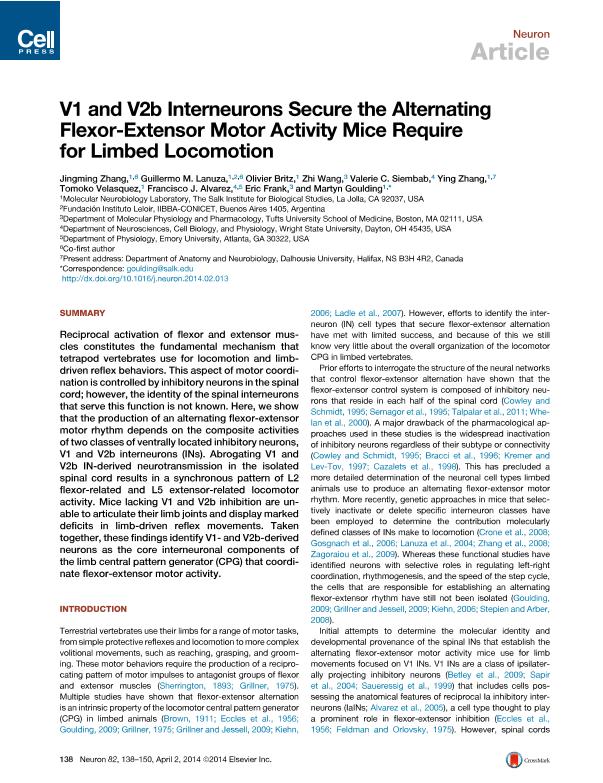Artículo
V1 and V2b Interneurons Secure the Alternating Flexor-Extensor Motor Activity Mice Require for Limbed Locomotion
Zhang, Jingming; Lanuza, Guillermo Marcos ; Britz, Olivier; Wan, Zhi; Siembad, Valerie C.; Zhang, Ying; Velasquez, Tomoko; Alvarez, Francisco J.; Frank, Eric; Goulding, Martyn
; Britz, Olivier; Wan, Zhi; Siembad, Valerie C.; Zhang, Ying; Velasquez, Tomoko; Alvarez, Francisco J.; Frank, Eric; Goulding, Martyn
 ; Britz, Olivier; Wan, Zhi; Siembad, Valerie C.; Zhang, Ying; Velasquez, Tomoko; Alvarez, Francisco J.; Frank, Eric; Goulding, Martyn
; Britz, Olivier; Wan, Zhi; Siembad, Valerie C.; Zhang, Ying; Velasquez, Tomoko; Alvarez, Francisco J.; Frank, Eric; Goulding, Martyn
Fecha de publicación:
04/2014
Editorial:
Elsevier
Revista:
Neuron
ISSN:
0896-6273
Idioma:
Inglés
Tipo de recurso:
Artículo publicado
Clasificación temática:
Resumen
Reciprocal activation of flexor and extensor muscles constitutes the fundamental mechanism that tetrapod vertebrates use for locomotion and limbdriven reflex behaviors. This aspect of motor coordination is controlled by inhibitory neurons in the spinal cord; however, the identity of the spinal interneurons that serve this function is not known. Here, we show that the production of an alternating flexor-extensor motor rhythm depends on the composite activities of two classes of ventrally located inhibitory neurons, V1 and V2b interneurons (INs). Abrogating V1 and V2b IN-derived neurotransmission in the isolated spinal cord results in a synchronous pattern of L2 flexor-related and L5 extensor-related locomotor activity. Mice lacking V1 and V2b inhibition are unable to articulate their limb joints and displaymarked deficits in limb-driven reflex movements. Taken together, these findings identify V1- and V2b-derived neurons as the core interneuronal components of the limb central pattern generator (CPG) that coordinate flexor-extensor motor activity.
Palabras clave:
Motor System
,
Spinal Reflex
,
Interneuron
,
Cpg
Archivos asociados
Licencia
Identificadores
Colecciones
Articulos(IIBBA)
Articulos de INST.DE INVEST.BIOQUIMICAS DE BS.AS(I)
Articulos de INST.DE INVEST.BIOQUIMICAS DE BS.AS(I)
Citación
Zhang, Jingming; Lanuza, Guillermo Marcos; Britz, Olivier; Wan, Zhi; Siembad, Valerie C.; et al.; V1 and V2b Interneurons Secure the Alternating Flexor-Extensor Motor Activity Mice Require for Limbed Locomotion; Elsevier; Neuron; 82; 1; 4-2014; 138-150
Compartir
Altmétricas



